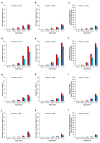Prevalence and 11-year incidence of common eye diseases and their relation to health-related quality of life, mental health, and visual impairment
- PMID: 33755897
- PMCID: PMC8298234
- DOI: 10.1007/s11136-021-02817-1
Prevalence and 11-year incidence of common eye diseases and their relation to health-related quality of life, mental health, and visual impairment
Abstract
Purpose: To study the prevalence and incidence of the most common eye diseases and their relation to health-related quality of life (HRQoL), depression, psychological distress, and visual impairment in the aging population of Finland.
Methods: Our study was based on two nationwide health surveys conducted in 2000 and 2011. Eye disease status data were obtained from 7379 and 5710 individuals aged 30 + years, of whom 4620 partook in both time points. Both surveys included identical indicators of HRQoL (EuroQol-5 Dimension [EQ-5D], 15D), depression (Beck Depression Inventory [BDI]), psychological distress (General Health Questionnaire-12 [GHQ-12]), visual acuity, and self-reported eye diseases. We assessed the impact of known eye diseases on these factors, adjusted for age, gender, and co-morbidities.
Results: Prevalence of self-reported eye diseases was 3.1/2.7% for glaucoma, 8.1/11.4% for cataract, and 3.4/3.8% for retinal degeneration in 2000 and 2011, and the average incidence between 2000 and 2011 was 22, 109, and 35 /year/10,000 individuals, respectively. These eye diseases were associated with a significant decrease in EQ-5D and 15D index scores in both time points. BDI and GHQ-12 scores were also worsened, with some variation between different eye diseases. Impaired vision was, however, the strongest determinant of declined HRQoL. During the 11-year follow-up the effect of eye diseases on HRQoL and mental health diminished.
Conclusion: Declined HRQoL associated with eye diseases is more related to impaired vision than the awareness of the disease itself, and this declining effect diminished during the follow-up. Therefore, information directed to the public on the risks and prevention of blindness can and should be strengthened to prevent the deleterious effects of visual impairment.
Keywords: Eye disease; Health-related quality of life; Incidence; Mental health; Prevalence; Visual impairment.
© 2021. The Author(s).
Conflict of interest statement
The authors declare that they have no conflict of interest.
Figures







References
-
- Ezzati M, Bentham J, Di Cesare M, et al. Worldwide trends in body-mass index, underweight, overweight, and obesity from 1975 to 2016: A pooled analysis of 2416 population-based measurement studies in 128.9 million children, adolescents, and adults. Lancet. 2017;390(10113):2627–2642. doi: 10.1016/S0140-6736(17)32129-3. - DOI - PMC - PubMed
-
- Flaxman SR, Bourne RRA, Resnikoff S, Vision Loss Expert Group of the Global Burden of Disease Study et al. Global causes of blindness and distance vision impairment 1990–2020: A systematic review and meta-analysis. Lancet Global Health. 2017;5:e1221–e1234. doi: 10.1016/S2214-109X(17)30393-5. - DOI - PubMed
-
- Bourne R, Jonas JB, Bron AM, Vision Loss Expert Group of the Global Burden of Disease Study et al. Prevalence and causes of vision loss in high-income countries and in Eastern and Central Europe in 2015: Magnitude, temporal trends and projections. The British journal of ophthalmology. 2018;102(5):575–585. doi: 10.1136/bjophthalmol-2017-311258. - DOI - PMC - PubMed
MeSH terms
LinkOut - more resources
Full Text Sources
Other Literature Sources
Medical

